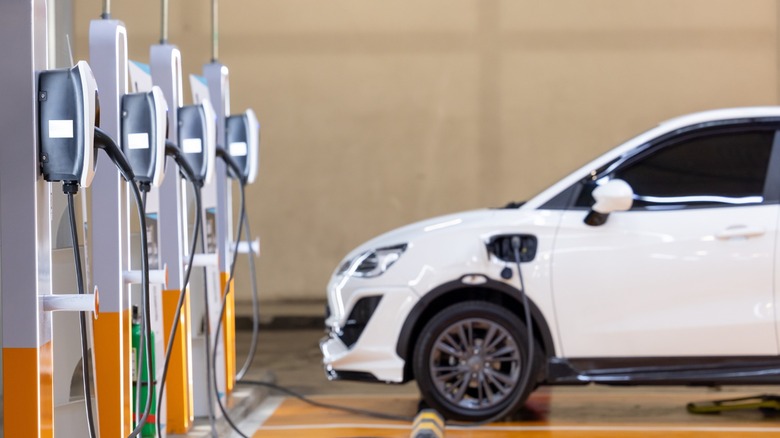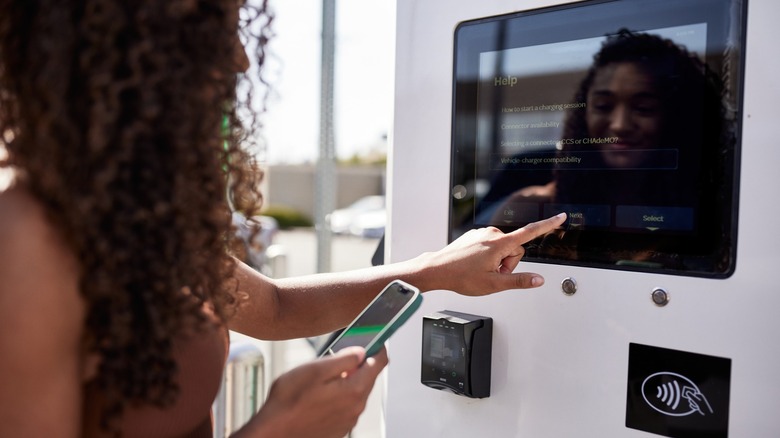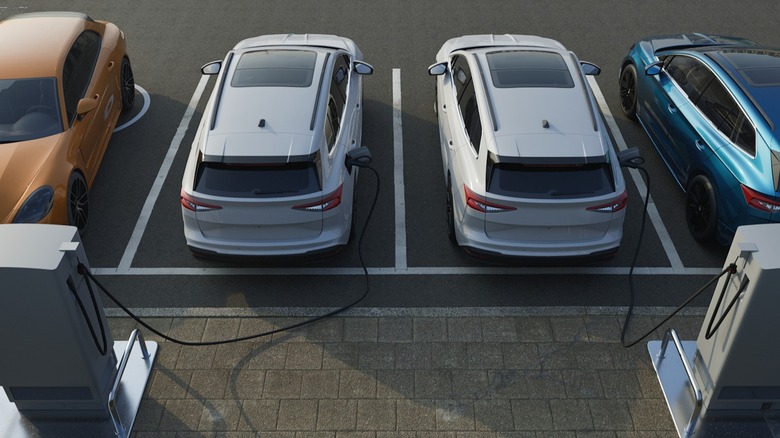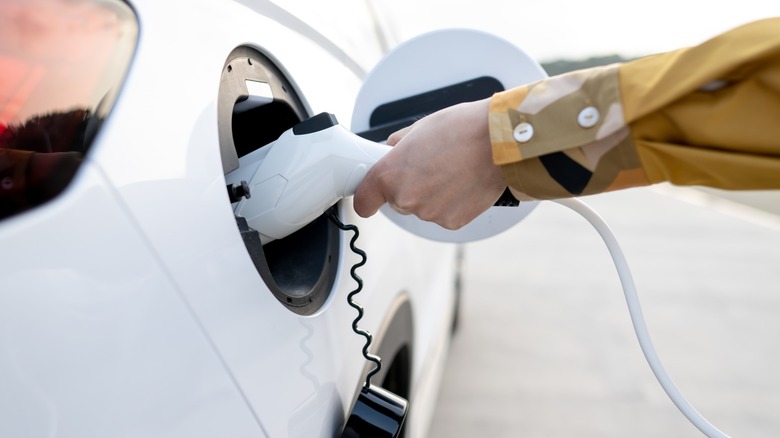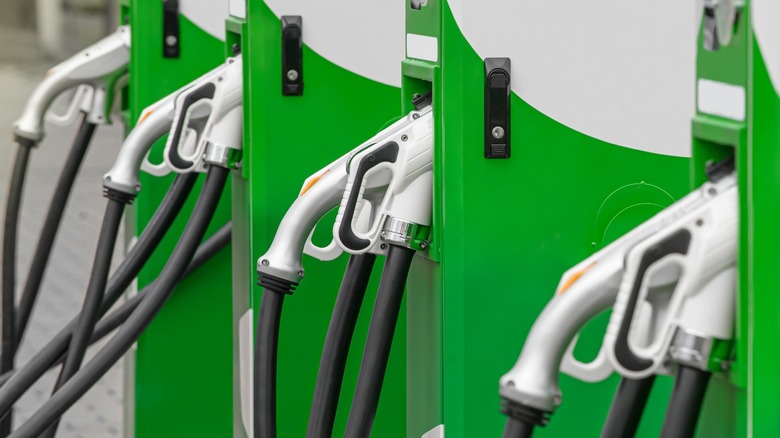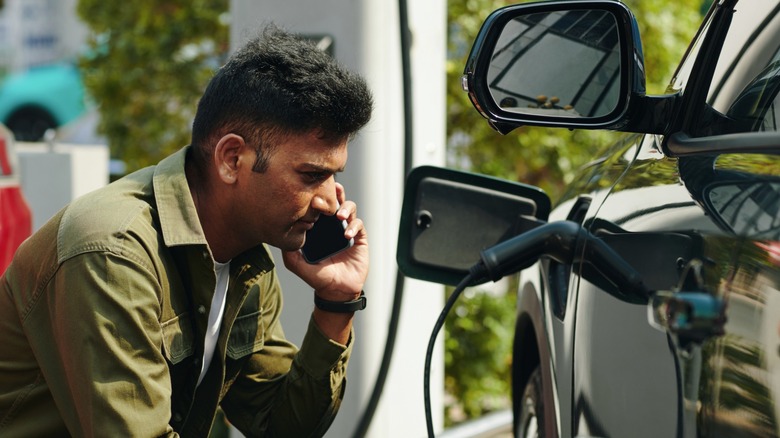EV Charging Etiquette Every Driver Should Know
In 2018, there were only about 300,000 electric vehicles on American roads, but that number has grown to more than 3 million over the past five years. As electric vehicles slowly become more popular, the way we treat public charging stations matters more than ever. While there's no official rulebook for EV charging, sticking to a few simple guidelines ensures that everyone enjoys a smooth and seamless experience.
Imagine pulling up to a charging station with a low battery, only to find someone parked there long after their car has finished charging. Or worse, an internal combustion engine vehicle is parked in the only available spot. It's easy to see how frustrating that situation can be. Poor charging etiquette can also be a burden to you as much as it can be to others. Being careless at a charging station can harm your EV's battery health, and in some cases, it might even lead to costly damage to the station itself, which likely took millions to install and maintain. By being mindful of how we use these shared spaces, we can help protect our vehicles and the infrastructure that keeps them running smoothly.
Use the right charger
The first thing to know about public EV charging stations is that they don't work like gas stations. At a gas station, it doesn't matter what kind of car you're driving: every pump works the same. You either choose gas or diesel, fill up, and head off. But when it comes to charging an electric vehicle, things are a bit more complex.
Not all EVs charge at the same speed, and not every charger delivers power at the same rate. It might be tempting to grab the fastest charger available, but if your car can't handle that speed, it's not going to get you back on the road any quicker. Worse, you could be holding up someone else whose vehicle can actually make full use of the faster charger. So, whenever you can make a choice, it's always a good idea to pick the charger that's right for your EV.
How you park matters, too. Always take a moment to park properly and make sure your car's charging port lines up with the station's charging bay. Sometimes, that means backing in, depending on where your port is. It might be a little effort, but it goes a long way in keeping things organized for everyone. That way, you're not blocking somebody else or disrupting.
Finally, it's important you know what kind of charger your car needs and how long it'll take to charge. Get familiar with the charging network's app, and make sure you've set up your payment details before you get to the station. We understand that setting up a new account each time you use a new charging network can be tedious; however, soon enough, with Plug and Charge technology, the process could become a lot smoother.
Don't park in charging spots unless charging
Perhaps the most important piece of EV etiquette is this: if you're parked in a charging bay, you should be charging. It sounds obvious, but you'd be surprised how often people park in these spots without actually plugging in. Even worse, some drivers leave their gas-powered cars in a charging spot, a habit known as ICEing or dock blocking. In some states, that can get you fined. So, remember at all times that charging bays are meant for EVs that need to recharge; they are not spots for convenient parking.
But even if you're driving an EV, that doesn't mean you should stay plugged in longer than necessary. Once your battery is full, move on. Some charging networks even charge idle fees if you stay connected after your car is fully charged, and those fees can add up quickly.
The good thing is that most EVs come with apps that let you monitor your charging status in real time, so you can keep track while you're grabbing some quick refreshments or running an errand. As soon as your car is ready, it's courteous to free up the spot for someone else, especially when you're at a busy station. If you'll be away from your car and not on your phone monitoring the status, consider setting a timer.
Another thing you should know is that your EV's charging speed slows down as your battery reaches 80 percent. This is intentional: it helps protect the battery and keeps it from overheating. So, while you might think staying plugged in for those last few miles is helpful, it's often not worth the wait, especially if you're not going on a long trip. Instead, unplug when you hit that 80 percent mark and give someone else the chance to charge their car.
Don't unplug another car
It might be tempting to unplug another EV, especially if you're in a rush and it looks like they've finished charging. But let's be honest: unplugging someone else's car is just plain rude. After all, you wouldn't want someone doing the same to you, right? Besides, most EVs have a locking mechanism that prevents anyone from disconnecting the car while it's charging, keeping both the vehicle and the charging process secure.
If you arrive and all the spots are taken, the best thing to do is respect the queue. Wait your turn, and if there's a waiting area or an informal lineup, make sure you let the other drivers know you're in line, too. Waiting can definitely be frustrating, especially if you're really low on battery, but unplugging someone else's car is not the solution. If you're really pressed for time, consider using apps like PlugShare to find other nearby chargers. Sometimes, heading to a different station can be more productive than waiting in line.
Of course, you might find yourself on the other side of the situation. If you're the one plugged in and aren't sure you'll make it back in time before your car finishes charging, consider leaving a note for other drivers. Let them know it's okay to unplug your car once it reaches a certain charge level or ask them to only disconnect it if there's been an emergency. Some drivers leave notes on their windshields, while others use their EV charging apps to communicate with fellow EV owners.
Overall, avoid waiting until your battery is almost empty before looking for a charging station. Try to top up your battery when you still have a comfortable amount of range left. That way, you won't be stranded or feel desperate when the station is busy.
Be careful when plugging and unplugging the connector
EV chargers are designed to be durable, but to stay in good working condition, you need to handle them with care. When you're plugging in, always make sure the connector is properly aligned before pushing it into place. Forcing the plug or not fully inserting it can damage both the charger and your vehicle's port. So, if something feels off, it's better to double-check than to risk damaging expensive equipment.
When it's time to unplug, take a moment to release the connector the right way. Don't yank it out. Instead, press the release button if there is one, and gently pull it free. After you've finished charging, always return the connector to its designated holder. Leaving it dangling or dropping it on the ground will only damage the charger or even create a safety hazard. When the cord is where it shouldn't be, someone could trip over it, step on it, or even drive over it.
One thing to keep in mind when using an EV charging station is that, unlike a gas station, there's usually no staff on hand to tidy up after you're done charging. That's why it's important to leave the area clean and organized for the next person. So, don't leave your trash behind. If you've had a snack or coffee while waiting for your car to charge, make sure to take any trash with you unless there's a garbage bin nearby. If there is a designated garbage bin, throw away your rubbish properly. Try not to litter.
Respect others in the stations
Always keep in mind that a public charging station is a shared space. When you need to communicate with others, speak in a civil and courteous manner. A polite conversation can help avoid misunderstandings, and if you've built a good rapport with other drivers, they might even keep an eye on your car if you need to step away for a bit.
If you see another driver struggling, offer to help. Even though more people are starting to trust EVs, we're still in the early days, and for many, this might be their first experience at a public charging station. Not everyone is familiar with how each charging network works, or they might not have the right apps installed. With your help, they might be able to have a smoother experience.
It's also important to follow any instructions provided at the charging station or through the app you're using. Some stations might require you to swipe a card or scan a QR code before you can start charging, and others may have time limits in place to keep things fair. If there's a limit on how long you can charge, be mindful of that, and don't stay plugged in any longer than necessary.
Report any issues to the appropriate authority
Every now and then, there's a good chance you'll visit a charging station that isn't working as it should. It could be anything from a broken connector to a hard-to-read screen or a faulty payment system. Whatever the issue, make sure to report it to the service provider right away, either through the station's app or by contacting their customer service line.
Many public charging networks rely on drivers to report problems, as they may not always know a station is down until someone flags it. By reporting an issue, you could help get it fixed faster. That way, other users aren't stuck or stranded. Also, in the spirit of community, some charging apps allow you to leave notes for other EV drivers, letting them know which chargers to avoid until repairs are made. This simple heads-up could save someone else from making a trip, especially when they might have to travel a distance to get there.
Lastly, keep in mind that EV infrastructure is still a work in progress. The number of public charging stations in the U.S. is growing rapidly. According to the Department of Energy, there were close to 29,000 public charging stations across the country in late 2020. By early 2024, that number had increased to over 61,000. And the number of charging networks is still expected to grow significantly in the coming years. So, while technical issues are bound to happen, they'll surely get better.
